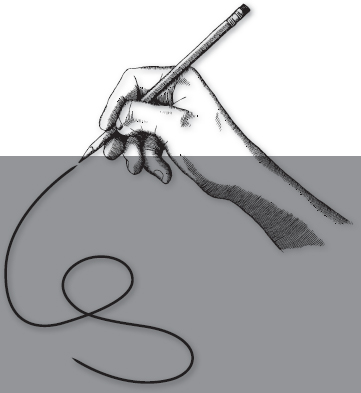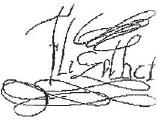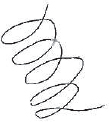
A signature is unique in the same way that a fingerprint is. It represents the image that the writer wishes to show the world at any specific time. A signature can change five or six times throughout one life span. Young people develop their own signatures around the age of fourteen, but an analysis of their handwriting should not be carried out until they reach maturity, and well after they have left school. By the time they are between the ages of twenty-one and twenty-seven, they will show signs of further changes to their handwriting, and a third period of change can be seen between twenty-seven and forty-two years. Further changes can occur in the fourth period, between forty-two and fifty-five years, and the fifth change happens from age fifty-five onward and will continue until an individual's faculties start to diminish and up until the time of death. In later life, the signature will remain the same but it may become shaky due to weakness in the arms, and it may start to slope downward due to illness or fatigue.
Many people use different signatures for different purposes. For instance, a small signature may be used when important documents or checks are signed. Another type of signature may be used when a quick note is jotted down. A celebrity may use another type when signing autographs. A signature and the body of the letter being similar indicates that the person usually behaves the same way, whether in public or in private. A person with a legible signature is usually sincere and reliable, open and honest, and this writer has a good balance of expression in his or her personality. Illegible signatures can show an attempt to deceive others.
People whose signatures are illegible may be vain individuals who consider themselves superior, and they like to keep their thoughts to themselves.
Ascending signatures indicate optimism, while descending signatures can reveal pessimism, particularly if the pressure is heavy.
Individuals who end their signatures with a dot are displaying an obstinate and conventional attitude. They don't like explaining themselves to others, and they may avoid having to interact with others at times. The forename is associated with the writer's earlier life or experiences. If the first name is larger or smaller, weaker or stronger, than the second name, then there are unconscious memories, good or bad, affecting the writer emotionally, and these are reflected within the script. When a married woman makes her first name larger than the surname, this might show that she is in an unhappy marriage.

A highly embellished signature with many whirls and loops shows a desire for attention. The writer is showing off, needs to be admired, and requires a lot of fussing in order to bolster a slight inferiority complex. Individuals with this type of signature are usually loud and noisy and want to be noticed.

A small signature displays inhibition, especially if the letters are squeezed and written tightly together. Such writers are withdrawn and show a need for protection, putting a distance between themselves and others for fear of getting hurt.

Signatures that are circled are indicative of writers who wish to withdraw. They are afraid of the world and other people, so they try to protect their ego by encircling their name in order to defend themselves and their loved ones. This handwriting feature can reveal depressive tendencies.

A rounded and legible signature shows signs of honesty and reliability. This writer may have right-slanting writing, which displays an amiable and friendly nature and the ability to communicate and mix well with others.
Many executive types will underline their signatures to add weight to their importance. Individuals who underline their signatures demonstrate a need to stamp their personality on the reader; this trait symbolizes a healthy ego and self esteem.
Many celebrities, show-business personalities, politicians, and others in the public eye tend to add a great deal of underlining flourish to their names in order to be noticed. Often the signature displayed is “over the top,” which is a show of vanity; the result is rather vulgar.
Those who underline their signatures do so in many ways, varying in the length, firmness, and formation of the line. Underlining a signature is an indication of self-emphasis. A signature with no underline portrays an attitude that is not demanding or showing a need to be recognized. In some cases the person's signature has no lower loops, so the addition of an underline is a way of drawing this lower area into the person's signature. Here are a few examples to illustrate this trait.

A long, thick underline can be an indication of aggression, with drive and energy toward progress.
An underline written with normal pressure demonstrates self-confidence and self-constraint.

A signature with a strong, rising underline to the right is an indication of a forward-thinking and ambitious individual.

An underline that is hooked at each end indicates that this individual is crying out for recognition. A hook on the left of the underline indicates a need for recognition of past achievements, and a hook on the right of the underline shows that the person is striving to achieve.

A crossed underline is indicative of a money-conscious person.

People who decorate the underline under their signatures find themselves fascinating and they are particularly concerned with their appearance. They may act or speak in an artificial manner to impress others.
A short underline created with light pressure is showing a lack of drive and energy.

A signature with several strokes to the underline can denote a self-assertive, overbearing, uncompromising individual.

The writer who has two different types of strokes underlining his or her signature is displaying a great need for attention. This individual may use an assumed manner of speech, dress, or behavior to impress others.
Crossed strokes underlining a name can indicate a sign of anger or a sarcastic streak. This writer does not suffer fools gladly and likes to be seen as a dominant individual.
People with small writing and a large signature are expending significant energy on overcoming the conflict between their private, quiet nature and a need to be noticed. The gap in the size, from small writing to a large signature, indicates a big difference between the way such people feel inside as private individuals—and how they present themselves as people who get attention.

Small writing accompanied by a small signature is often characteristic of a person who has good concentration skills but who also can be introverted. People whose handwriting is small and who have a small signature pay particular attention to minute details, so care should be taken to ensure that all the facts are at hand when working with them.
It is not unusual for people to sign their name a little larger than they normally write. This characteristic is a very common writing trait, and it is an indication that they are making an effort to be noticed.

A person whose signature is smaller than the accompanying text can be displaying inhibition, timidity, meanness, or unsatisfactory attitudes at home.